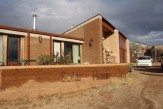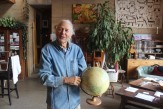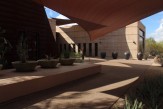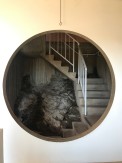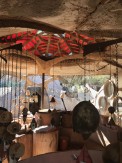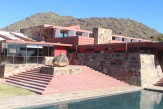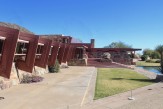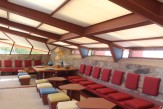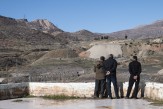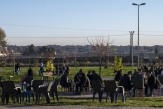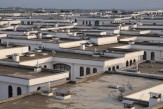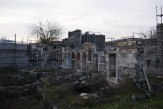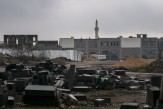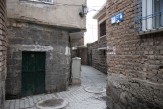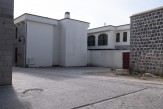2023–2024 Fellowship Recipients
Abdulrazaq Alabdulmighni | Florence & Rome, Italy
Grace Ballo | Scottsdale, AZ; Oakland, CA
Andrew Hebert | Diyarbakir & Hasankeyf, Turkey
Yuan (Alice) Meng | Tokyo / Kyoto / Osaka, Japan
Projects
-
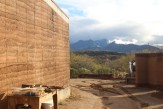
Grace Ballo
-

Andrew Hebert
-

Yuan (Alice) Meng
Back
Grace Ballo
Grace Ballo’s thesis work began with her interest in the Great Mosque of Djenne built in the 13th century in Mali—specifically the history of its construction and how traditional building techniques can be harmonized with new technologies while honoring Djenne's cultural rituals and heritage. Grace was awarded a fellowship to study innovative, sustainable approaches to building with earth-based materials. Focusing on arid regions of the US climatically similar to Djenne, Grace traveled to Scottsdale, AZ from which she visited several locations: Oracle and Tucson, where she met with Quentin Branch, founder of Rammed Earth Solar Homes and toured project construction sites; Phoenix, where she met with Otto Pappa, founder of Ottocrete, a multidisciplinary design firm specializing in rammed earth construction; Arcosanti, an experimental community established by the architect Paolo Soleri where she learned about Arcology; and Taliesin West, Frank Lloyd Wright’s desert home, where she met with Stephanie Lin, dean of The School of Architecture (TSOA).
Andrew Hebert
Andrew Hebert’s thesis examined contemporary projects of nation-building in the Republic of Turkey, a state formed through the violent collapse and reordering of the Ottoman Empire. It addressed Turkey’s Kurdish Question—with its aim of neutralizing, assimilating, and disappearing the nation’s largest ethnic minority—and its spatial manifestations, particularly in the country’s southeast. Infrastructural “development” and militarization both define the government’s disposition towards the Kurds, a people whose mere expression of identity has often been equated with terrorism and separatism.
The spatial violence of nation-building in the southeast is euphemistically referred to as “Turkification”: this manifests itself in the renaming of streets, the policing of organizations, the uprooting of villages, the destruction of cultural heritage, and the forced annihilation of collective memory. Governmental projects addressed to Kurds—from irrigation canals to military checkpoints, from public housing to urban renewal schemes—can all be traced to the “master plan” of the nation. As Turkey continues to build itself, Andrew’s thesis investigated the architectural forms and methods within which nation-building and (ethno-)nationalism materialize.
The William Cooper Mack Thesis Fellowship allowed Andrew to spend ten days in Turkey’s southeast, primarily in the city of Diyarbakir and the town of Hasankeyf, to better understand the social and material aspects of the national project of Turkification. His trip consisted of two parts: participating in a travelling workshop as part of the Arazi Assembly Collective, and an independent exploration of the city of Diyarbakır. He then spent two days collecting his thoughts and contacts in Istanbul before returning to New York. His encounter with the people of Diyarbakır and the Arazi Assembly Collective initiated an ongoing collaboration, and he intends to help co-edit a publication on Diyarbakır with the Collective.
Yuan (Alice) Meng
Alice Meng’s thesis explored the urban market as both an architectural typology shaped by local economic structures and as an urban phenomenon fostered by social and communal forces. More specifically, she focused on bolstering local urban economies by introducing a hybridized architectural system: a “third space” of commercial exchange that situates itself between the centralized supermarket structure and the traditional form of wholesale and vending activities.
Drawing inspiration from historical marketplaces deeply embedded in their respective neighborhoods, Alice sought to understand how these vibrant centers have sustained themselves as dynamic hubs of local communities. Using fellowship funding, she travelled to Japan, where she focused on the "Shotengai" typology of traditional Japanese market streets woven into the urban fabric across various cities and scales. She visited major urban centers such as Tokyo, Kyoto, and Osaka to better understand the nuanced ways in which these covered streets are integrated into diverse neighborhoods and how they facilitate meaningful interactions between local communities and visitors. In addition to visiting similar retail markets in smaller counties like Kanazawa and Morioka to understand spatial relationships inherent in the Shotengai typology, regardless of their size or location, Alice also explored wholesale markets such as Tsukiji Market and Toyosu Market to examine the storage and distribution of goods within urban environments. These experiences enriched her understanding of the intricate dynamics shaping Japan's market landscape.

